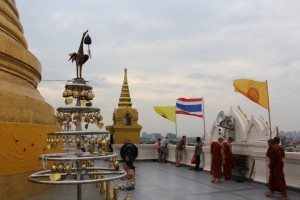
Wat Saket, Bangkok
Bangkok
Ok, so I just couldn’t resist with that headline. But seriously, there is so much to see and do in Bangkok, and I’m not talking about lowbrow “entertainment” – culture, food and history abound in this exciting Southeast Asian megacity! I visited Bangkok in January 2012.
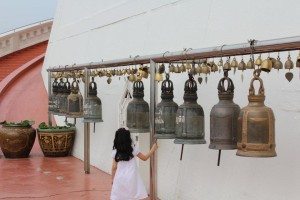
Wat Saket, Bangkok
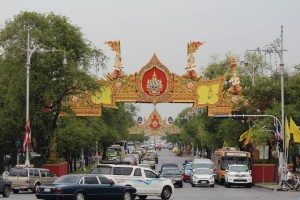
Ratchadamnoen Street, Bangkok
In my first couple of days in Bangkok before I had managed to see much of the old part of the city; I visited Wat Saket, an important Buddhist temple on the top of a small hill (and therefore with great views). Throughout all of my temple visits I had noticed the massive gongs outside, and snapped many of these innately oriental instruments in my photos. Similarly, many small bells jangling outside the temples were often the only sound to be heard. Another thing I’ve noticed, interestingly, is that due to the design of Buddhist temples, I have been forced to take many of my photos in portrait orientation, rather than landscape, as I found so often suits Islamic architecture.
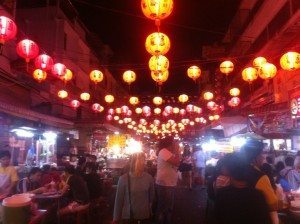
Bangkok’s Chinatown
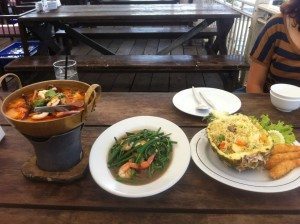
Thai food near the Rama VIII Bridge
On my first night in Bangkok I met up with an old friend of mine who took me for dinner in Chinatown, where I slurped delicious noodle soup. Following that, I thankfully didn’t fall sick after a jelly/condensed milk/ice dessert which looked too good to resist. The next day we went for lunch near the modern King Rama VIII Bridge and I found out why people love the sour/spicy Tom Yum Prawn Soup. (If you’ve never tried Tom Yum Soup, or if you’ve tried it in Australia but didn’t like it, do yourself a favour and come to Thailand. Get your mouth burnt out by one today and discover how soup can be a highly addictive meal in itself! Unless you dislike coriander or seafood – in that case it’s probably not worth it).
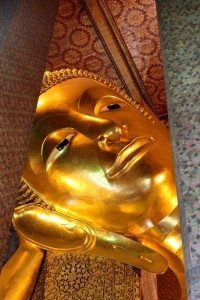
Wat Pho Buddha, Bangkok
We then moved on to Wat Pho, Bangkok’s temple of the reclining Buddha, and what a Buddha it is! Gilded in gold, the truly enormous statue fills an entire two storey building; its smiling face watches peacefully over those who walk past it. Around the complex were other, smaller stupas
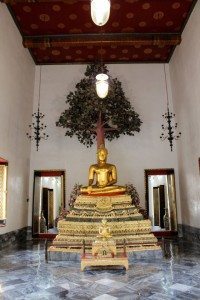
Wat Pho, Bangkok
each contributed by a former king of Thailand. Except, that is, for Wat Arun, a larger stone stupa built across the river from Wat Pho. Although not much bigger than some of the city’s other stupas, the attraction in this temple lies in its accessibility; after a quick boat ride over the Chao Phraya River, one can climb the steep (like, seriously steep) steps to the top tier. I scaled the tower which gave me great views across the river and the city.
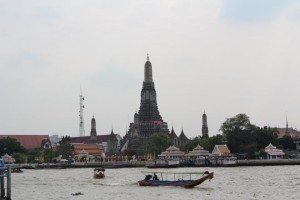
Wat Arun, Bangkok
Diagonally across the river, behind Wat Pho, lay the Royal Palace with its magnificent golden rooflines. The people of Thailand are very proud of their royal family, who they see as being the gatekeepers of Thai Buddhism as well. Regardless of what political turmoil is going on (and in Thailand, there’s always something), the one thing that everyone can agree
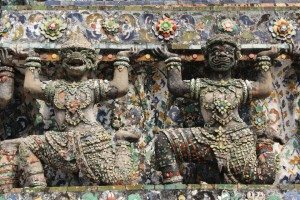
Wat Arun sculpture work
on is their respect for the king’s authority. The current king, His Majesty King Bhumibol Adulyade was 85 when I visited, and had been on the throne for almost 66 years, making him the world’s longest-serving current head of state. He had been in and out of hospital over the past few years, leading most Thai’s to wonder what comes next – a military coup in 2006, a state of political emergency in 2008, and a violent uprising in 2010 all demonstrate how important it is for Thailand to have a universally supported leader.
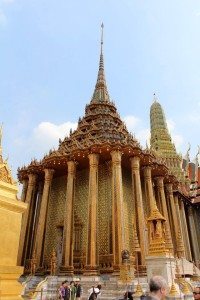
Temple of the Emerald Buddha, part of the Royal Palace complex, Bangkok
On Sunday I met caught up with another friend of mine to visit the royal palace. The traditional palace is no longer used, except for functions and banquet dinners. The royal family live in a smaller (but still luxurious) modern mansion to the south. It’s still within the royal palace complex, and visitors are allowed to take pictures through a gate, a bit like at Buckingham Palace. The historic palace was smaller than Buckingham Palace, but the entire complex was full of more temples and stupas. One temple in particular houses an “emerald Buddha” – although it is actually sculpted of jade instead of emerald, the green deity is fairly prized because of its unusual material. Later still, we went to the
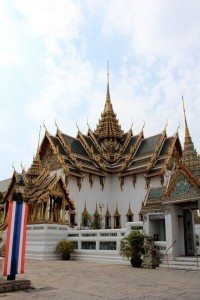
Historic Royal Palace, Bangkok
Royal Regalia Museum, the Ananda Samakhom Throne Hall, where thrones, gifts and regalia of monarchs past are on display. Some of the pieces – such as a pure gold and diamond model of a sailing boat – would be worth millions. No photography was allowed in the throne hall, which was the location in 2006 of a special banquet hosted by the king. He invited monarchs from around the world to dine in the sumptuous surroundings to celebrate his 60th year on the throne. There are some great pictures floating around the internet of this banquet – it all looks rather cordial, although I can’t imagine they would have broken out the Pictionary after dinner.
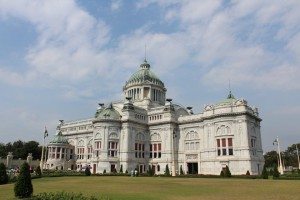
Ananta Samakhom Throne Hall, Bangkok
And did I mention one night is never enough? Neither is one article! That’s why you’ll need to stay tuned for my next instalment of Bangkok travel and sightseeing!
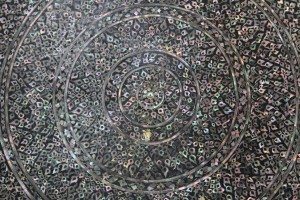
Mother of pearl inlay at Wat Pho, Bangkok
When to go
December and January – it won’t be too rainy, or too hot, although you will have to share the sights with sundry other holidaymakers. The middle of the year can get very hot and humid.
Essential Stats
Culture shock: 5/10
Language difficulty: 4/10
Quality of food: 9/10
Cost: 4/10
Physical demand: 3/10
Advice and warnings
The usual precautions apply – no walking alone at night if you can help it, keep a close eye on your valuables, etc. Be aware of pickpockets, especially in crowded places.
Check Smart Traveller or the British Foreign Office for more comprehensive warnings.
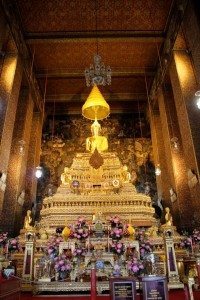
Wat Pho, Bangkok
Visas
Most Australian passport holders are eligible for a 30-day visa on arrival, free of charge at Bangkok’s airports. Pakistanis must apply to the Royal Thai Embassy in Islamabad; visas cost PKR 4000 and take at least four working days to process. See the website for the list of documents required. Indian passport holders are eligible for a 15-day visa on arrival so long as they can produce the necessary documents on arrival at the airport in Bangkok. For stays longer than 15 days, Chennaikers may contact the Royal Thai Consulate – General in Chennai.
Getting there and around
THAI flies to Bangkok at least once daily from each of Melbourne, Lahore, Sydney and Chennai. All THAI flights arrive and depart from Survanabhumi International Airport (Bangkok’s main airport).
Melbourne (from $1079 return)
Lahore (from PKR 61,759 return)
Sydney (from $1096 return)
Chennai (from INR 23,306 return)
Discount airline Air Asia flies from Melbourne to Bangkok via Kuala Lumpur from $513 return, while Sydney to Bangkok via Kuala Lumpur is from $547 return. Air Asia flies directly from Chennai to Bangkok from INR 10,826 return. Note that Air Asia uses Don Mueang Airport in Bangkok, the older airport which is now popular with discount airlines.
Discount airline Jetstar flies directly from Melbourne to Bangkok with fares starting from $563 return. They operate into the main Bangkok airport at Survarnabhumi.
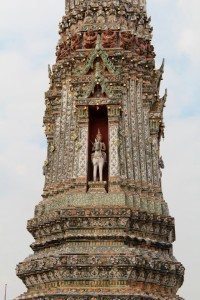
Wat Arun’s stupa, Bangkok
Taxis in Bangkok are cheap, plentiful and should be metered – if not, then ask the driver to flick it on and they usually oblige. Occasionally a flat rate will be asked for during peak hours – it’s normally around the same, but feel free to shop around if you think you’re being ripped off. The BTS Skytrain and the underground metro system are both excellent, but not really useful for the old city – much better for the shopping areas. To get along the river, consider a riverboat – it’s cheap, scenic, and beats the traffic jams on the roads.
Accommodation
I stayed at the cheap and cheerful Penpark Place. All major hotel chains have a presence in Bangkok, or for other cheap options, go to Hostelworld.com.

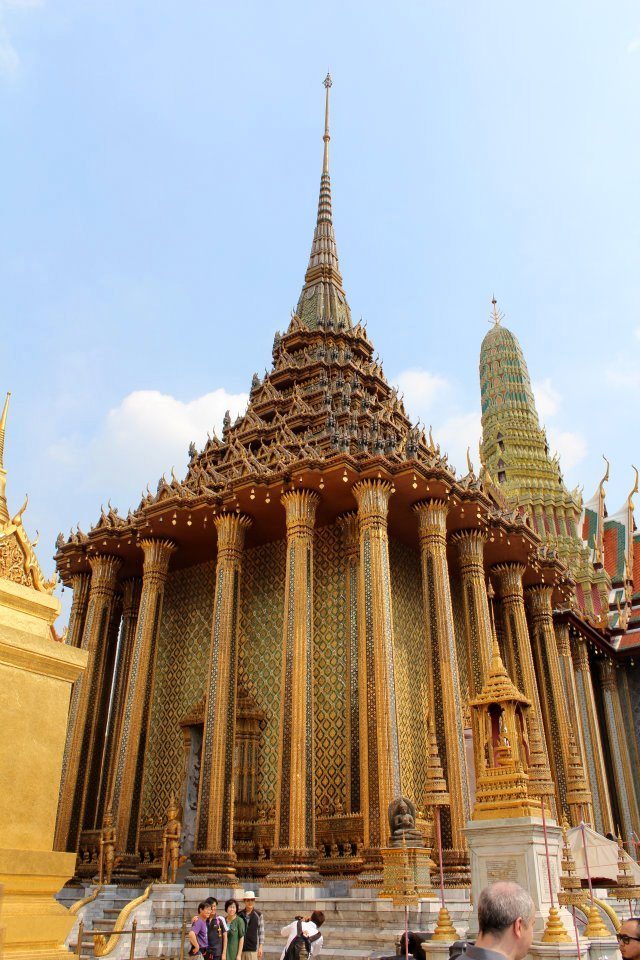



Sometimes a week is not enough to fully experience the beauty and charm of Bangkok. I always come back to this city when catching international flights back home. I’m in love with Thai cuisine, but to be honest, Bangkok is way too touristy for me nowadays.
I still love Bangkok – yeah it’s touristy, but it’s still lots of fun. I guess it depends what you’re looking for – I love the big city life, so I still really like Bangkok 🙂 Thanks for reading Agness!! 🙂